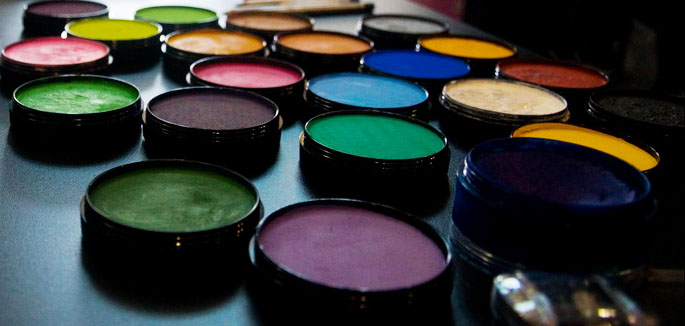Day: what to use for body painting
Colors
by Stefano on Feb.09, 2010, during Body Painting
The question I most often is made by the observer (sometimes a bit’ naively) while performing a bodypaint is' What colors are?’ – 'But then come off with water ?’
Having reassured the public and shaping, maybe with a hint of irony ( 'Sure, with some’ acetone is it all away ') Switch off what is often there, with some dismay of the viewer to know that just a little’ soap and water can undermine all the work within minutes of our day.
But we've never really wondered what we in the colors we use, and if we can reproduce ? In fact, the costs of the colors continuously increasing (wafers of AQUACOLOR 4mg in traditional colors, I found yesterday by a dealer authorized to 5,50 Euro l'una!) is pushing more people to walk the path of experimentation.
For better or for worse.
While using food coloring (that plus the easiest to find – be sure not thinking of coloring the skin by using acrylic, true ?!) is the relative security to avoid allergic reactions and skin toxicity (according to the logic of 'if we can eat, surely we can also spread it on ') you still need to pay particular attention that the product is also easy to remove, and do not leave undesirable spots on the skin.

If you want to go a little’ deeper into what, and accurately analyze the contents of a color to BodyPaint, here is the list of ingredients (in order of use):
- Distilled water (in the case of course is based liquid and not waffle)
- Cetearyl Alcohol – Cetearyl alcohol (emollient / emulsifier / stabilizing emulsions / opacizzante / viscosizzante)
- Sodium Laureth Sulfate – also known as SLS (schiumogeno)
- Octyldodecanol – Octildodecanolo (emollient and solvent)
- Cetyl Alcohol – Cetyl Alcohol (emollient / emulsifier / opacizzante / viscosizzante)
- Stearic Acid – Stearic Acid (emulsion / stabilizing emulsions)
- Propylene Glycol – Propylene glycol (umettante / solvent)
- Triethanolamina – Trietanolamina (pH balancing)
- Glycerin – Glycerol (denaturante / umettante / solvent)
- Sodium Laury Sulfate
- Lenath-40
- Sodium Borate – Borace (buffering agent)
- Dimethicone – (antischiuma / emollient)
- Sodium Chloride – Sodium Chloride (viscosizzante)
- Talcum – Talc (absorbent)
- Methylparaben – Metilparaben (preservative)
- Perfume – Perfume
and, depending on the color of one or more of the following colors:
- Titanium Dioxide – Titanium Dioxide (White) Cl 77891
- Iron Oxides and Mica- Metal oxides and mica Cl77491 Cl77499
- yellow5 Cl19140:1
- Ultramarines Cl7707
- Ferric Farrocyanide Cl77510
- Cl Red7 15850
- Red38 Cl12085
- Yellow 6 Cl15985:1
- Red40 Cl16035
- Pigment Yellow 1 Cl11680
- Barium Sulfate Cl77120
Although not all the-shelf components, are quite common, especially in liquid soaps and shampoos.